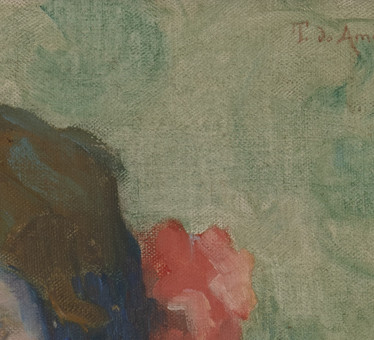Tarsila do Amaral

Capivari, Brazil, 1886 —
São Paulo, Brazil, 1973
Arriving in Paris in 1920, Tarsila do Amaral enrolled in the traditional Julien Academy and only discovered modernism when he returned to Brazil, after living with the São Paulo modernist circle. In his second stay in Paris, studying at the studios of Lothe, Gleizes and Léger, he will say that he found his Brazilian identity: “I feel more and more Brazilian. I want to be the painter of my culture. ” In fact, although she did not participate in the Week of 22, Tarsila is a key figure in the unification of ideas hitherto dispersed in the group of Brazilian modernists regarding the synthesis of European and native references.
In 1923, he painted “A Negra”, a strong, large, simplified figure, on a geometrical background and a large banana leaf, pointing to the amalgam between avant-garde form and Brazilian theme. In 1924, he initiated paintings from the so-called Pau-brasil phase, characterized by the chromatic boldness of the country palette and candid contemplation of the world. From this phase, Estação de Ferro Central do Brasil (1924) reflects the urban and social transformations that the country was going through, establishing the coexistence of electricity poles and railways with palm trees and colorful houses. Despite the presence of the signs of modernity, the general effect of the composition tends more towards the naive than towards a futuristic celebration of technology. The puerile reappears in works that deal with the theme of folklore, such as “A Cuca” (1924), with elements of Brazilian fauna and flora and creatures of the popular imagination.
In Abaporu (1928), Tarsila presents the gigantic figure, with a torso and disproportionate limbs in relation to the head, which inspired Oswald de Andrade to write the Manifesto Antropófago, presenting the Brazilian Indian no longer as the good savage, but as the cannibal, who it incorporates the strength of the foreigner, rescuing the irrational mentality repressed by Western culture. Also from this phase are paintings by Tarsila such as Antropofagia (1929), O Ovo and A Lua (both from 1928). All of them exhibit mysterious figures surrounded by the dreamlike and the pre-logical, pending the surreal.
During the 1930s, the painter turned to social work, focused on the working class. The constant becoming of Tarsila’s work is a sign of the variety and mutation of his object of investigation: Brazil. By making the country appear in brilliant colors, in the innovative representation of the human figure, in the land that oscillates under the weight of dreams, it cannot be concluded that Tarsila was simply to meet Brazilianness, but that she helped to create this very quick Brazilianness .
VRP
Women Ahead
It's never too late to pay homage to women. On the last day of March 2020, Dan Galeria presents the collective Mulheres à Frente, bringing together Brazilian artists of extreme relevance and participation in our history of art.